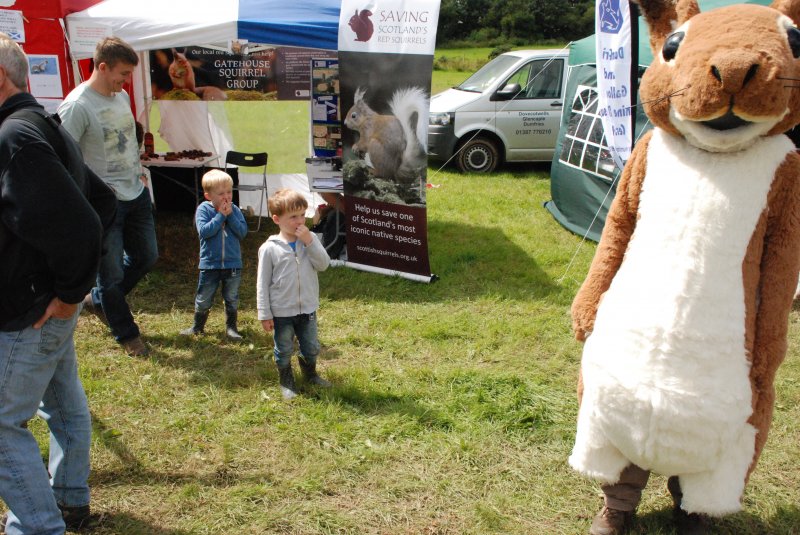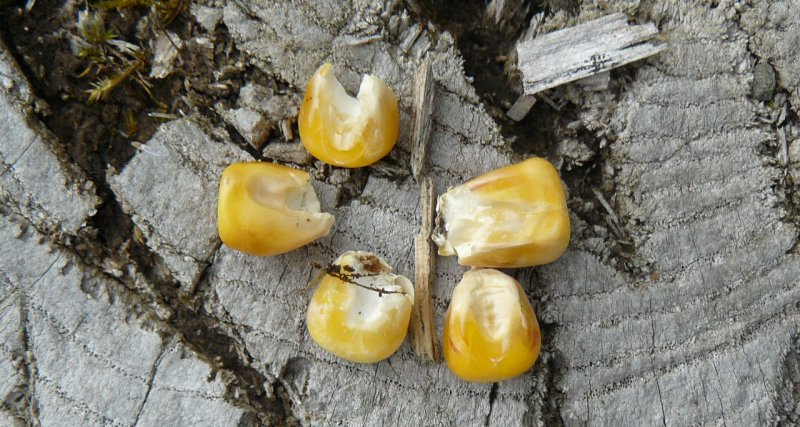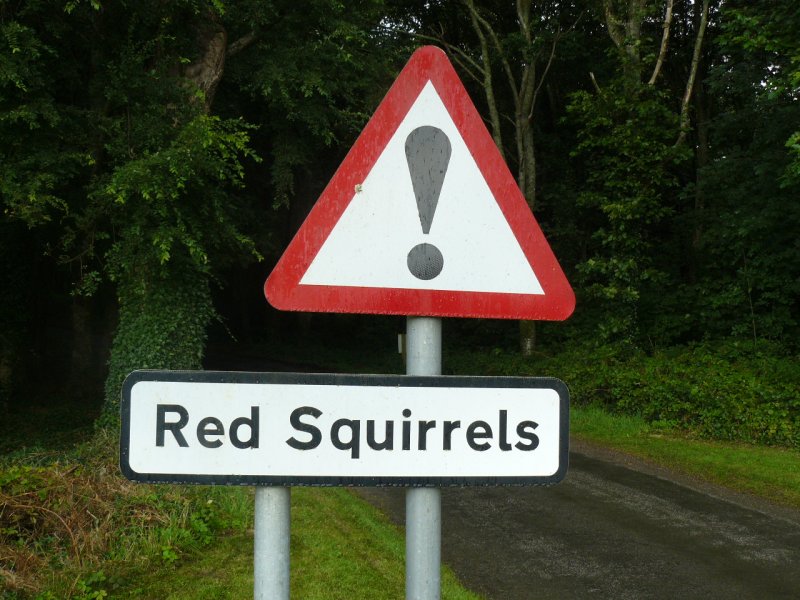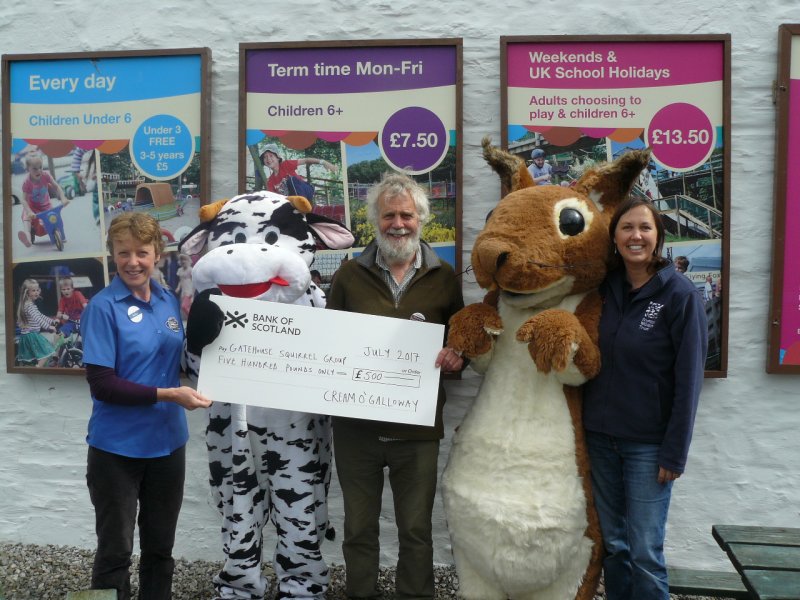Original Author: Peter Garson
Peter Garson, Chair of Gatehouse Squirrel Group and Saving Scotland’s Red Squirrels volunteer, tells us about how he and his local community are working to ensure red squirrels continue to have a home in Dumfries & Galloway.
When I moved to Galloway in the autumn of 2013, I was somewhat dismayed to gather just how widespread grey squirrels had become. For the previous 25 years, my wife and I had been living on the edge of a Scots pine forest near Hexham in Northumberland, where for a long period we had plenty of reds visiting our garden. We even organised aerial ropeways to feeders on our window frames, giving us even closer views! Then one autumn squirrelpox struck, and they were all gone in a few weeks. So we had to move, didn’t we…
Before coming to Galloway, I was on the Biology staff at Newcastle University, where I lectured for years on conservation biology, including the devastating worldwide effects of invasive species introductions. It was natural, therefore, for me to work for more than a decade with others on the ecology of red squirrels in their Kielder Forest stronghold, just as greys were creeping into Northumberland from the north, west and south. On reaching Gatehouse after I retired, I soon encountered Heinz Traut, then working as the Saving Scotland’s Red Squirrels Project Officer for Dumfries & Galloway (and now with our sister project in Northumberland!). I also saw the Glenkens Red Squirrel Group come into existence in 2014 and was persuaded to start up a group in Gatehouse in early 2015.
Although we only get odd sightings of greys here, individuals testing positive for squirrelpox have previously been recovered from surrounding Newton Stewart, Dalbeattie and New Galloway, so the need for grey control can never be overlooked. The old-fashioned methods are all we’ve got until the magic bullet arrives— most likely in the form of a magic (albeit very expensive) molecule to effectively sterilise greys. Meanwhile there is definite evidence of pine martens in our area, so hopefully they will help us out a bit too.

Citizen Science
Whilst we are still waiting to see a pine marten on our bird table at home, we do enjoy living with our very visible reds. I have set up a census (currently of around 20 gardens) to track the local population trend. Each month I collect two numbers from each participant: the greatest number seen at the same time, and the number that can be recognised individually. Since January 2017 we have been ‘flatlining’ on average, but most people get at least two visitors by either measure. If things change for the better or worse, I think we will notice pretty quickly, and in any case it’s fun to watch our reds more closely.
The area around Gatehouse is an important tourist destination, and our publicity emphasises the red squirrels and other wildlife to be seen nearby. The Cally Woods have long been a popular spot, with impressive red squirrel warning signs along the road to the Cally Palace Hotel. The mix of conifers and broadleaved tree species there, along with food provided by local residents, makes it more red-friendly than the oak woodlands that stretch up the Fleet valley to the north of the town – including the Scottish Wildlife Trust’s own Carstramon Wood Nature Reserve. In fact we are lucky: all the woods around Fleet Bay and up the valley support reds. We established this by carrying out surveys in the spring and autumn of 2015 with feeding hoppers and sticky tapes, as an extension of the annual SSRS spring survey. We may even be a bit blasé about our reds, having been admonished lately by SSRS for being rather too good at reporting greys, and thus making our bit of the online map look like a disaster zone! I now have a small army of over 50 local contacts on the lookout for both species, with more people asking to join in, and tourists doing their bit as well.
When doing our hopper surveys in 2015, we were in a position to detect greys, but completely failed to do so. Even though there were sightings during our survey periods, no greys left hairs at our hoppers. Using camera-traps we also discovered that some reds will feed on maize in the same way greys do, by simply removing the germ and leaving a notch at the base of the discarded grain. So this field sign is not a signature for greys, as some people believe!

Conservation in action
We hold a stock of traps and four group members are trained and registered with Saving Scotland’s Red Squirrels for grey control operations. Our experience so far suggests that sightings can sometimes lead to successful grey control, although trapping is often time-consuming and unsuccessful in our present situation. Shooting works better if you have any group members with a firearm, a licence and plenty of patience. Fortunately we have one such person – our secret weapon! Most of our grey sightings are one-offs, and we suspect these are recent arrivals still on the move. They are like ghosts and defy all control efforts, probably because they have already left before we arrive to do something about it. But if we can keep the greys at bay, and thereby reduce the risk of a pox outbreak, I think we can expect to hold on to our reds for a long time to come.

Community support
Our progress to date has been made easier through the support of Gatehouse Development Initiative and Cream o’Galloway. We have also received small grants from Red Squirrels in South Scotland, the Murray-Usher Foundation and Gatehouse Community Council (Common Good Fund). Whilst we are grateful for this help, our main asset is the enthusiasm and commitment of our growing force of volunteers. Recently they turned out to spread the word from our stalls at the Gatehouse Gala event at Cream o’Galloway, the Stewartry Show in Castle Douglas and the Kirkcudbright Country Fair. Community involvement, and indeed ownership, of this campaign is the only answer for now.

For more information on getting involved with Gatehouse Squirrel Group, email gatehousesquirrels@gmail.com

